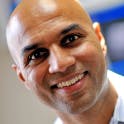How an OSHA visit made me a better leader of my dental practice
Just like his fellow dentists, Ankur A. Gupta, DDS, wants to be an effective leader of his dental practice. But it took a visit from OSHA to help him recognize his priorities and value his staff.
I hired Kathy as a dental assistant three months after opening the doors to our practice. She has impressed me through the years as a tremendously loyal, hard-working, infectiously positive contributor to our team. She embodies so much of what I value in a team member, and I often make my sentiments clear to her through verbal and written appreciation, bonuses, and the unofficial, unspoken position as “head” assistant. Such a status affords her a fair amount of deference when decisions need to be made about changes to the structure of our clinical operations. If we feel that our endo sponge system seemed antiquated, for example, she is always involved with the upgrade process in some way.
A few years ago, we held a full-day team meeting focused exclusively on OSHA and bloodborne pathogens. (Lucky us!) A guest speaker visited our office and gave us the latest updates, rules, and regulations, and of course, toured our administrative and clinical domains and encouraged us to make changes. The changes were not only to maintain legality, but also to offer our patients the cleanest, most risk-free atmosphere possible.
Kathy’s discomfort with this process was truly palpable. As the OSHA specialist perused our sterilization space and made suggestions, it truly looked as though a bowl full of ants had been deposited in Kathy’s pants. At one point during a break I was able to catch her alone in and ask, “So, Kathy, what do you think?”
“This is bulls***,” was her poignant response. So, there it was. We were faced with an impasse. One option was to embrace changes that, while temporarily inconvenient, would result in real improvement in our practice operations. The other option, of course, was to simply embrace whatever success we’d shared by doing things the way “we’ve always done them.”
This impasse, and so many like it, ARE WHAT MAKE OUR LIVES AS ENTREPRENEURS INTERESTING. It is during these moments that we have the opportunity to develop as leaders, to step out of our comfort zones and take the more difficult road and risk some pain and difficult conversations. The other option, of course, is to maintain the status quo.
In order to determine next steps, we must ask ourselves about our values. This seems easy, but I have found it extremely difficult, not only as a practice owner, but also as a parent, spouse, and all the other arenas in which conflict might occur in my life. My nature (not my value) has always been to avoid conflict at all costs. Moreover, I have always prided myself in being a pleasant and easy-going individual. I like being liked, and following the status quo makes a person tremendously likable.
Upon determining my values, unfortunately, I realized that following the status quo was something that I really could not continue to do in this situation. If we had policies in the office that put our patients at unnecessary risk, that unfairly favored the whims of certain team members over others, or made the office less than the best it could be overall, then those policies needed to be eliminated.
How does someone determine his or her values? This question is easy to answer when it comes to some things. I rarely meet an adult who doesn’t possess a clear identity when it comes to hot-button political issues. How ironic that we devote our intelligence and energy creating a clear identity toward things that have a vague impact on our day-to-day lives. But when it comes to the values we possess as practice owners, where real people—our families, patients, and teams—are directly affected by our adherence to such values, our identities are often fuzzy at best.
Here are some questions that might help you in this process.
1. When an improvement is suggested in your office, how does it become integrated? Who is in charge of making it happen, the owner or the person who suggests it? How is it “sold” to the rest of the team? How are all team members held accountable for its implementation?
2. With respect to the first question, how are dissenters addressed? What about chronic dissenters?
3. When conflict arises between team members in your office, what are the steps that should be taken before the issue is brought to your attention? What issues require immediate intervention from you or the office manager?
4. How would you rank the following characteristics of the ideal team: punctuality, knowledge and ability, good attitude, and teamwork? Ideally someone can have them all, but which is most important to you?
Answering these questions is important, but more important is to actually share your values with your team members and explain that you are committed to these values. Admit to them that you are on a journey that has many uncertainties and fears, and that you truly need them not only as employees, but as a part of your team. Even if they don’t completely embrace your values and commitments, they are responsible for helping realize them. The result is not only a greater sense of responsibility from them toward you, but also the realization that the practice that you own and that they work in is something in which they have ownership.
I wish I could say that Kathy doesn’t secretly grumble every time she walks by the six fire extinguishers or wall sticker in the lab that says, “No food or drink.” She probably does. What she probably also realizes, though, is that with all this talk of commitment and values and trust, well, it applies to how we see her as well. We are committed to her and we value her, and we are willing to go through temporary inconveniences in order to make that known.
For the most current practice management headlines, click here.
For the most current dental headlines, click here.
Ankur A. Gupta, DDS, started a practice from scratch, North Ridgeville Family Dentistry, in 2005 with his wife, Nisha E. Punjabi, DDS. Armed with what he considered adequate knowledge, hand skills, and personable demeanor, he watched as his practice floundered, finances became unpredictable, and his lower back and life outlook became worrisome. Rather than continue the trend, he attempted any and all personal and professional “experiments” in self-improvement. He now enjoys terrific new patient numbers and case acceptance, a solution-oriented dental team, and most importantly, a meaningful and positive identity. He shares the failures and successes with dental groups throughout the country. Contact him at [email protected].







